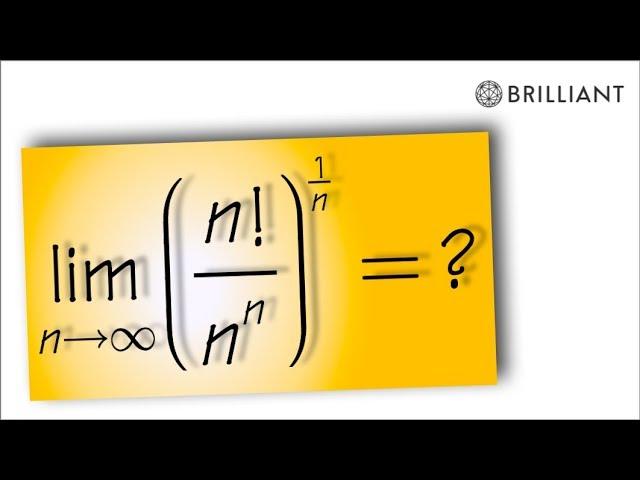Комментарии:

Such an irony I just solved this question couple hours ago😂
Ответить
Can we use the Stirling approximation of factorials for this?
Ответить
indeed it is brilliant
Ответить
got a math test tomorrow, hope it will help ( yes I rather look at a video i know nothing about ouvre working )
Ответить
The part with riemann sum is just genius
Ответить
This has to be one of the most beautiful math ive ever seen
Ответить
This topic is taught to 12th grade students in india
Ответить
Absolutely brilliant
Ответить
Brilliant…
Ответить
What an absolutely brilliant solution! This is one of the coolest limits I've ever seen, thank you so much for showing this to the world!
Ответить
thank you for amazing explanation 😊
maybe a stretch, it looks like it can be solved by taking that root
lim{n->°°}(n!/n^n)^(1/n) = lim{n->°°}(n!^(1/n)/n) = lim{n->°°}1*(2^(1/n))*...*((n-c)^(1/n))*...*(n-1)^(1/n)) all of the constants turn into 1, therefore lim{n->°°}((n-c)^(1/n))*...*(n-1)^(1/n)) ~ lim{n->°°}((n-c)^(c/n)) = lim{n->°°}((n+k)^(-k/n)) = lim{n->°°}(n(1+(k/n))^(n/k)) = e^k*lim{n->°°}(n)^(n/k)) = e^k = (e^-c) = 1/e^c

Why does e keep showjng up everywhere
Ответить
using my methods i just found out that ((loggamma(n+1) - n * log(n)) * (1 / n)) the bigger n is the closer it is to -1 and exp(-1) is e ^ -1 which is 1 / e
so the ans. is 1 / e

That was the question my high school teacher gave me to solve as the first question of definite integral as a limit of sum
Ответить
The only thing the title was missing was the exclamatory sign ,btw sir your videos really changed my thought process thank u ❤
Ответить
And why did you use ln and not a general log?
Ответить
I may be mistaken, but wouldn’t ln(n!/n^n) be a discrete function if we use the normal definition of factorials and not the gamma function definition? Because then you can’t just plug any value for n in 1/n.(ln(1/n) + ln(2/n) + … ln(n/n))
Ответить
just use stirling lol...but riemann series works as well
Ответить
Hai fatto capire benissimo la tua esperienza esilarante. Complimenti per il video!
Ответить
we can use Stirling's Formula approximation for n!. as the limit tends to infinity n! ~ √(2πn)(n/e)^n
Ответить
Become very easy with stirling formula lmao 😅
Ответить
Does this work with any logarithm base or does it have to be the natural log?
Ответить
🥺wooww💝
Ответить
You could easily use L'Hopital... (ln(1/n) + ln(2/n)....)/n is the infinity upon infinity form
Ответить
This is a very beautiful limit 😍
Ответить
I had a big smile when you made the connection between the series and a Riemann sum.
Ответить
This beautiful limit is literally like one of the starting questions from the infamous black book of Kota
Ответить
Multiply power to both numerator and denominator which makes denominator 'n', so limit will become zero
Ответить
The no nut november equation
Ответить
does this even work though since factorial requires n to be an integer, so n cant continuously increase as required for an integral
Ответить
You can solve the integral of ln x from 0 to 1 easily by using the inverse function of ln x. The area is actually equal to the negative of the area under the curve of e^x from -infinity to 0, because they are inverse functions, so you can solve that easily to get -1.
Ответить
What? But n∈ℕ, what are you taking the area from???
Ответить
Why
Why would you do this

For the first step, if you took the logarithm of both sides with a base other than e, would the answer still work out to be 1/e? (For example, if you took log base 5 of both sides initially instead of ln)
Ответить
Να εφαρμοσουμε Stolz υπολογιζεται πιο γρηγορα και ευκολα
Ответить
Stirling's formula enables us to calculate the limit quickly :)
Ответить
I got also 1/e
I just know that when the function n/(n!)^(1/n) goes to infinity is e
And the function (n!/n^n)^(1/n) can be simplified into ((n!)^(1/n))/n
Now the function is similar to the other limit but just being he reciprocal

If L was being multiplied by ln, why didn’t he divide the right side by ln instead?
Ответить
götlükler ezberimde
Ответить
Why not use the Gamma fumction instead of n! - you never said!
Ответить
Didn't watch the video, but based on Stirling's approximation I'm gonna say it's equal to e
Ответить
I used the Stirling formula; n!~sqrt(2*pi*n)*((n/e)^n), and i got e^-1 as well.
Ответить
I thought the result would be 1 because 1/infinity leads to 0 and any number raised to zero is 1
Ответить
I didn't understand why the area under the curve is equal to minus one.
Ответить
Good
Ответить


























